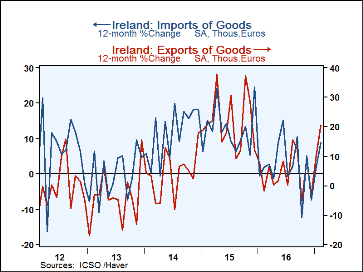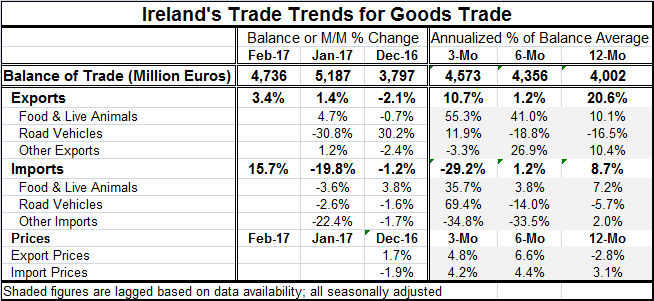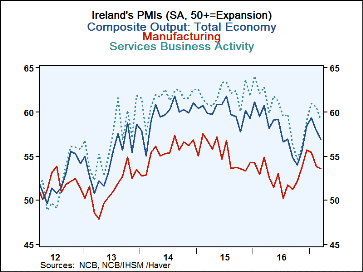 Global| Apr 18 2017
Global| Apr 18 2017Ireland's Trade Trends Struggle to Stabilize
Summary
Ireland showed a sharp gain in exports and a particularly explosive gain in imports in February. The import surge comes on the heels of a previous monthly collapse which takes all of the lift out of this latest gain. The sequential [...]
 Ireland showed a sharp gain in exports and a particularly explosive gain in imports in February. The import surge comes on the heels of a previous monthly collapse which takes all of the lift out of this latest gain. The sequential trends for export and import growth still are not settling down as neither exports nor imports show a clear pattern of acceleration or deceleration. Over 12 months, both flows are up strongly. Over six months, both flows are up by the skin-of-their-teeth. And over three months, exports are up while imports are quite weak.
Ireland showed a sharp gain in exports and a particularly explosive gain in imports in February. The import surge comes on the heels of a previous monthly collapse which takes all of the lift out of this latest gain. The sequential trends for export and import growth still are not settling down as neither exports nor imports show a clear pattern of acceleration or deceleration. Over 12 months, both flows are up strongly. Over six months, both flows are up by the skin-of-their-teeth. And over three months, exports are up while imports are quite weak.
Food and live animal shipments have generally strong and accelerating growth properties. Export flows are steadily accelerating, and while imports formally are not, they also tend in the direction of acceleration.
Road vehicle exports and imports show declines over 12 months and six months for both exports and imports; then both flows pop higher over three months especially for imports.
For the rest of trade, which amounts to 90% of it for exports and 83% of it for imports, the patterns remain vexing. Other exports are up solidly over 12 months and accelerate further over six months only to show a modest rate of decline over three months. For imports, the year-on-year gain is small at 2% then substantial declines in shipments are posted over six months and 12 months.

 Perhaps none of that is too surprising based on Ireland's overall economic performance that has also been erratic. The PMI data show that Ireland 'boomed' from 2013 through late-2015, then slid into a period of substantially weaker growth but avoided actual contraction. Since mid-2016, Ireland has been reviving strongly again, but with a recent 'tail' to the uptrend. Still, the manufacturing PMI is solid and the service sector PMI is relatively strong. We would expect to see some pick-up in import flows with such growth dynamics, but recent Irish import trends are weak. Actual year-on-year Irish manufacturing output changes have been close to flat or lower for the past year. Despite the more upbeat PMI readings, actual manufacturing output has been stagnant and the retailing sector has been steadily slowing.
Perhaps none of that is too surprising based on Ireland's overall economic performance that has also been erratic. The PMI data show that Ireland 'boomed' from 2013 through late-2015, then slid into a period of substantially weaker growth but avoided actual contraction. Since mid-2016, Ireland has been reviving strongly again, but with a recent 'tail' to the uptrend. Still, the manufacturing PMI is solid and the service sector PMI is relatively strong. We would expect to see some pick-up in import flows with such growth dynamics, but recent Irish import trends are weak. Actual year-on-year Irish manufacturing output changes have been close to flat or lower for the past year. Despite the more upbeat PMI readings, actual manufacturing output has been stagnant and the retailing sector has been steadily slowing.
Of course, Ireland is caught up in all the Brexit madness. Some financial firms consider Ireland a good location for post-Brexit operations and those sorts of shifts are only starting to commence. Ireland also has been affected by the Brexit-related weakness in the British pound which should have made U.K. firms more competitive, but again we do not see a surge in Irish imports overall.
Clearly, Irish macro and trade data reflect somewhat topsy turvy conditions in Ireland as well as a swirl of policy change around it ranging from Brexit to erratic conditions in the euro area to the potential for another referendum in neighbor Scotland. Through all of this, the balance on the trade account has remained relatively steady and in surplus. Its stability belies the storm of trends that have spilled over the Irish economy.
Robert Brusca
AuthorMore in Author Profile »Robert A. Brusca is Chief Economist of Fact and Opinion Economics, a consulting firm he founded in Manhattan. He has been an economist on Wall Street for over 25 years. He has visited central banking and large institutional clients in over 30 countries in his career as an economist. Mr. Brusca was a Divisional Research Chief at the Federal Reserve Bank of NY (Chief of the International Financial markets Division), a Fed Watcher at Irving Trust and Chief Economist at Nikko Securities International. He is widely quoted and appears in various media. Mr. Brusca holds an MA and Ph.D. in economics from Michigan State University and a BA in Economics from the University of Michigan. His research pursues his strong interests in non aligned policy economics as well as international economics. FAO Economics’ research targets investors to assist them in making better investment decisions in stocks, bonds and in a variety of international assets. The company does not manage money and has no conflicts in giving economic advice.






